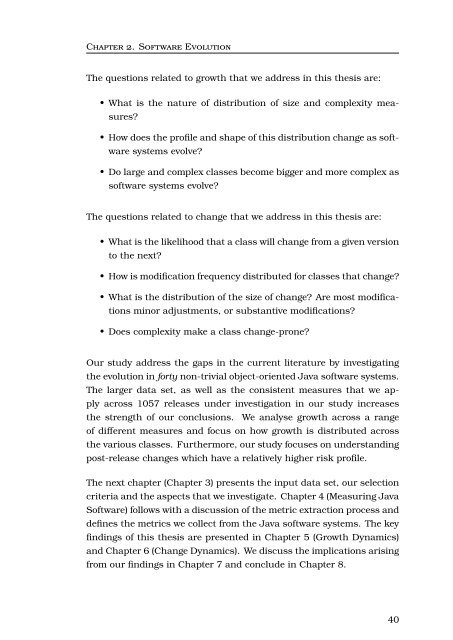thesis - Faculty of Information and Communication Technologies ...
thesis - Faculty of Information and Communication Technologies ...
thesis - Faculty of Information and Communication Technologies ...
You also want an ePaper? Increase the reach of your titles
YUMPU automatically turns print PDFs into web optimized ePapers that Google loves.
Chapter 2. S<strong>of</strong>tware Evolution<br />
The questions related to growth that we address in this <strong>thesis</strong> are:<br />
• What is the nature <strong>of</strong> distribution <strong>of</strong> size <strong>and</strong> complexity measures?<br />
• How does the pr<strong>of</strong>ile <strong>and</strong> shape <strong>of</strong> this distribution change as s<strong>of</strong>tware<br />
systems evolve?<br />
• Do large <strong>and</strong> complex classes become bigger <strong>and</strong> more complex as<br />
s<strong>of</strong>tware systems evolve?<br />
The questions related to change that we address in this <strong>thesis</strong> are:<br />
• What is the likelihood that a class will change from a given version<br />
to the next?<br />
• How is modification frequency distributed for classes that change?<br />
• What is the distribution <strong>of</strong> the size <strong>of</strong> change? Are most modifications<br />
minor adjustments, or substantive modifications?<br />
• Does complexity make a class change-prone?<br />
Our study address the gaps in the current literature by investigating<br />
the evolution in forty non-trivial object-oriented Java s<strong>of</strong>tware systems.<br />
The larger data set, as well as the consistent measures that we apply<br />
across 1057 releases under investigation in our study increases<br />
the strength <strong>of</strong> our conclusions. We analyse growth across a range<br />
<strong>of</strong> different measures <strong>and</strong> focus on how growth is distributed across<br />
the various classes. Furthermore, our study focuses on underst<strong>and</strong>ing<br />
post-release changes which have a relatively higher risk pr<strong>of</strong>ile.<br />
The next chapter (Chapter 3) presents the input data set, our selection<br />
criteria <strong>and</strong> the aspects that we investigate. Chapter 4 (Measuring Java<br />
S<strong>of</strong>tware) follows with a discussion <strong>of</strong> the metric extraction process <strong>and</strong><br />
defines the metrics we collect from the Java s<strong>of</strong>tware systems. The key<br />
findings <strong>of</strong> this <strong>thesis</strong> are presented in Chapter 5 (Growth Dynamics)<br />
<strong>and</strong> Chapter 6 (Change Dynamics). We discuss the implications arising<br />
from our findings in Chapter 7 <strong>and</strong> conclude in Chapter 8.<br />
40
















